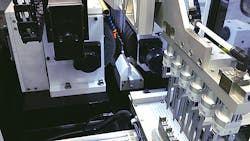New Centerless Grinding Concept Targets Fuel-Injection Valves
Glebar Co., which describes itself as a developer of “modular machine systems,” released details of a centerless grinding process it has devised for its GT 610 CNC machine, intending it as a tool for automotive parts manufacturers to expedite design and production of fuel injector nozzle valves. The system would reduce tooling costs, lower inventory levels, and speed integration of new technology for prototyping or proof of concept for a new component.
The centerless grinding development process for manufacturing a fuel injector nozzle valve can be a long and difficult project, sometimes needing to incorporate up to 20 critical dimensions, all of which must be completed as centerless ground. The new Glebar approach reportedly will increase the efficiency of centerless grinding prototyping process by using a single disk CVD dress roller as part of its grinding system, with the full CNC work wheel dressing.
“Glebar’s CNC dressing system, running on our GT 610 CNC machine platform, has sub-micron positional accuracy which allows intricate forms to be dressed into the work wheel to generate critical dimensions required in the manufacture of the fuel injector nozzle,” said Sean Riess, senior applications engineer. “By utilizing a single disk roller, this allows the end user to generate a multitude of profiles using one roller rather than being required to purchase a reverse-plated roller for every different profile when generating a proof of concept. This leads to shorter lead times and reduced inventory and initial tooling costs in development projects.”
As part of its new method for developing new fuel-injection nozzle valves, Glebar offers its P4K non-contact measurement system as a set-up and inspection tool. Adjustments are made from the P4K by feeding back radii, steps, diameters, and angle measurement to adjust the wheel shape automatically via the CNC dressing system. (Glebar has filed for a patent on correcting the wheel shape, it reported.) Using the off-line gauge eliminates trace measurement systems as well as optical comparators.
All of the interface software is custom generated internally to feedback to the machine for infinite wheel shapes.
“Historically, project development lead times for ground components of finished ground fuel injector nozzle valves can take upwards of 16 weeks to complete,” Riess explained. “This is due to the extremely long lead time of a reverse-plated dressing wheel, which can be very accurate, but an expensive tooling cost when proving out a component concept. With Glebar’s single roller solution, the need for reverse-plated wheels is eliminated, resulting in tremendous cost savings.”
Riess commented on the manufacturers’ and machine shops’ need for their machine tool centers and related systems to be “multi-faceted and vertically integrated. There is constant pressure to incorporate the latest technology since it’s hard to absorb the cost of the limited processes of grinding one piece per cycle,” he detailed. “While utilizing a reverse-plated wheel in a production environment of these components is often ideal, using a single disk CVD roller with CNC dressing can expedite a proof of concept and reduce development costs.”
Glebar provides shops the ability to grind multiple parts per cycle with gauge feedback and complete feeding automation. With the new advantage of versatility — i.e., being able to use single disk rollers as well reverse-plated rollers — Glebar customers can fast-track development projects and schedule fully automated, long-term production runs.
About the Author
Robert Brooks
Content Director
Robert Brooks has been a business-to-business reporter, writer, editor, and columnist for more than 20 years, specializing in the primary metal and basic manufacturing industries.


